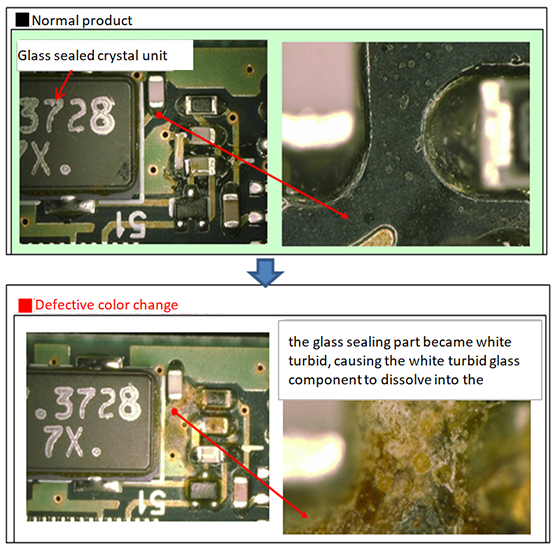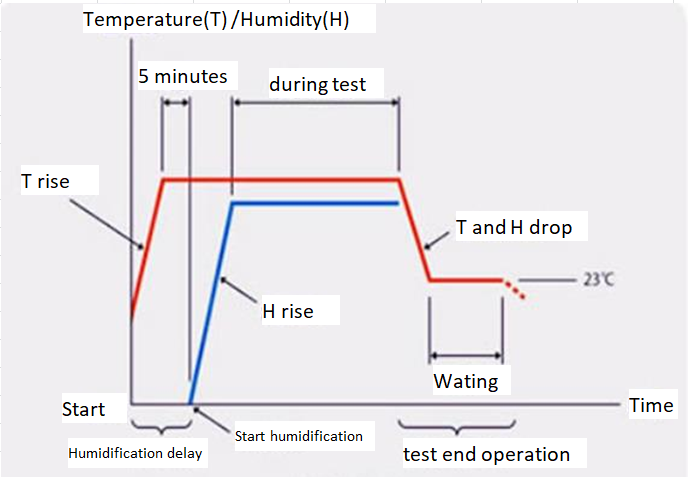Technology
Points to Prevent Condensation in High Temperature and High Humidity Leaving Tests of Crystal Products
The following explains the points of the high-temperature and high-humidity exposure test for quartz products.
1. Initial-high-temperature and high-humidity exposure test
Crystal products are tested under high-temperature and high-humidity environmental conditions for a long time.
However, if the operating conditions of the high-temperature and high-humidity exposure test tank or the product is taken out improperly in order to measure the results in the middle, the crystal products are taken out under high relative humidity conditions, and condensation occurs on the surface of the product because the crystal products become cooler than the surroundings. Unexpected problems may occur if crystal products are exposed to dew condensation.
2. Example of trouble in high-temperature and high-humidity storage test caused by condensation
<Defective color change of glass-sealed crystal resonator>
If the test is continued with condensation on the glass sealing part in the high-temperature and high-humidity exposure test, the glass sealing part may become white turbid, causing the white turbid glass component to dissolve into the moisture, resulting in a problem that flows out on the PCB. (Fig. 1)

Fig 1: Discoloration of glass sealed crystal units after exposure to high temperature and high humidity
This discoloration is due to the fact that lead oxide (PbO) contained in low-melting-point glasses used for sealing crystal unit reacts with moisture and becomes lead hydroxide Pb (OH) 2, resulting in white turbidity.
If this reaction progresses, the sealing glass may melt and leak, resulting in non-oscillation.
PbO+H2O⇒Pb2+ +2OH- ⇒Pb(OH)2↓
<Non-oscillation due to electrode disconnection of seam-sealed type crystal resonator>
If the test is continued with condensation on the external terminals (side surfaces) of the base in a high-temperature, high-humidity exposure test, electrodes may be disconnected due to the action of the local batteries, resulting in non-oscillation.
Between crystal unit internal and external terminals, internal wirings are connected via W (tungsten) and Ni internal wirings.
The external terminals are Au-plated and are not affected by condensation.
However, electrodes inside the routing are made of Ni and W electrodes.
When condensation occurs, internal wirings are fed to the supply source, and metal ions such as Ni and W dissolve into the water.
This phenomenon is called the local battery action.
When the reaction progresses, internal wiring is disconnected, resulting in non-oscillation or frequency shift. (Figs. 2 and 3)

Fig. 2 Disconnection due to condensation in high-temperature and high-humidity test

Fig. 3 Mechanism of W melting
3. Points of dew condensation prevention
(1) If the door is opened while the sample is being taken out from the high-temperature, high-humidity storage tank for intermediate measurement, etc., the temperature in the tank may drop and condensation may form on the surface of another sample in the tank.
(2) When starting a high-temperature, high-humidity test, condensation can be prevented by raising the temperature before humidifying and delaying humidification for about 5 minutes after reaching the predetermined temperature.
(3) Stop humidification first when performing intermediate measurements, etc. of high-temperature and high-humidity exposure tests. Then, naturally cool down the sample to room temperature, and then open the door to take out the sample to prevent condensation of the sample in the tank.
Fig. 4 shows the points for preventing condensation during high-temperature and high-humidity tests.

Fig. 4 Operation to prevent condensation during high-temperature and high-humidity tests
For condensing temperature/humidity and saturated vapor pressure, refer to JISZ-8806 "Saturated Water Vapor Pressure of Humidity Measuring Methods".
For more information about the high temperature and high humidity exposure test methods, refer to JIS60068-3-4, JISC60068-2-78.
4. Summary
Using crystal unit as an example, we explained a case in which a problem occurs due to condensation.
However, in order to prevent condensation, we would like you to take measures to prevent the door of the high-temperature and high-humidity tank from being opened during a high-temperature and high-humidity test.
In addition, please consult with the manufacturer of the high-temperature and high-humidity tank or your company's maintenance department and prepare the temperature and humidity control programming in advance so that the temperature and humidity at the time of equipment startup and shutdown are the profiles shown in Fig. 4.
